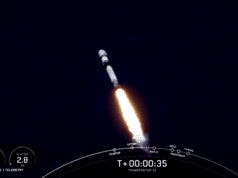![]() US: Phragmites australis, an invasive species of plant called common reed, grows rapidly into dense stands of tall plants that pose an extreme threat to Great Lakes coastal wetlands. Early treatment is the key to controlling Phragmites.
US: Phragmites australis, an invasive species of plant called common reed, grows rapidly into dense stands of tall plants that pose an extreme threat to Great Lakes coastal wetlands. Early treatment is the key to controlling Phragmites.
Scientists from Michigan Technological University’s Michigan Tech Research Institute (MTRI), the US Geological Survey (USGS), Boston College and the US Fish and Wildlife Service (USFWS) mapped the US coastline of all five Great Lakes using satellite technologies. Combined with field studies along those coastlines to confirm the satellite data, the map shows the locations of large stands of the invasive Phragmites located within 6.2 miles of the water’s edge.
The results of their three-year study are reported in a special issue of the Journal of Great Lakes Research focusing on remote sensing.
The Phragmites map is the first of its kind. Lead author Laura Bourgeau-Chavez, a research scientist at MTRI in Ann Arbor, Mich., calls it “a highly accurate data set that will allow national, regional and local managers to visualise the extent of Phragmites invasion in the Great Lakes and strategically plan efforts to manage existing populations and minimise new colonisation.”
Invasive Phragmites can displace native vegetation and reduce the quality of the habitat, the scientists say, altering nutrients in the soil and water, decreasing the diversity of animals and plants that normally live there, increasing air temperatures, drying wetland soils and trapping sediments. Mature stands of Phragmites often reach 16-feet tall, interfering with shoreline views, which can lower property values.
Using synthetic aperture radar (SAR), the researchers were able to use the longer wavelengths of SAR (approximately 23 centimeters) to distinguish between high biomass invasive Phragmites and other types of wetland vegetation. It also helped them detect flooding under a canopy of plants. For the entire Great Lakes basin, the overall accuracy of the resulting map was 87 per cent.
To validate their classification of the satellite data, similar information was collected by hand at random sites throughout the coastal wetlands of the Great Lakes during 2010 and 2011. By the end of 2011, a total of almost 1,200 half-acre field sites had been checked.
Lakes Huron and Erie turned out to have the greatest amount of invasive Phragmites. The project identified a smaller extent of Phragmites in Lake Michigan but only a few stands in Lake Ontario and almost none in Lake Superior.
Source: MTU




